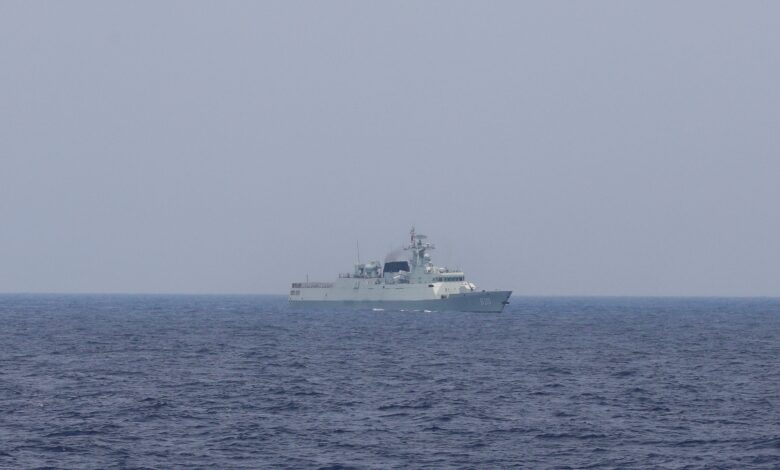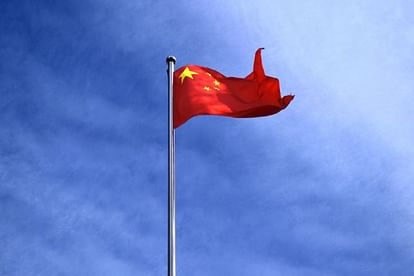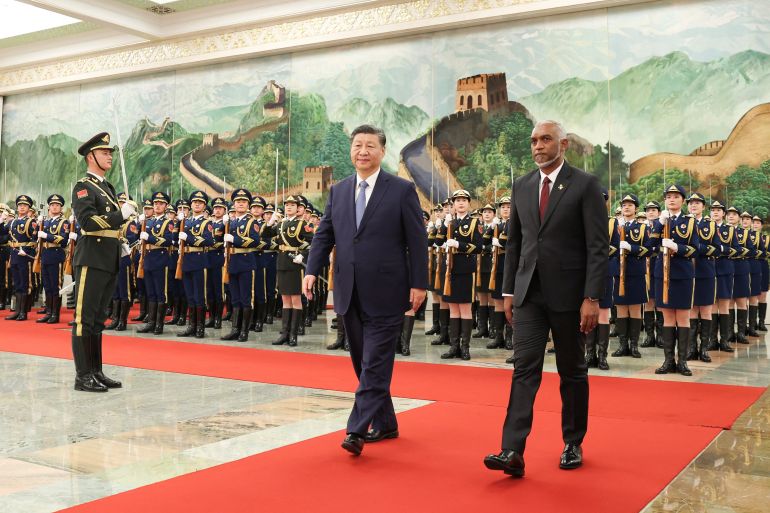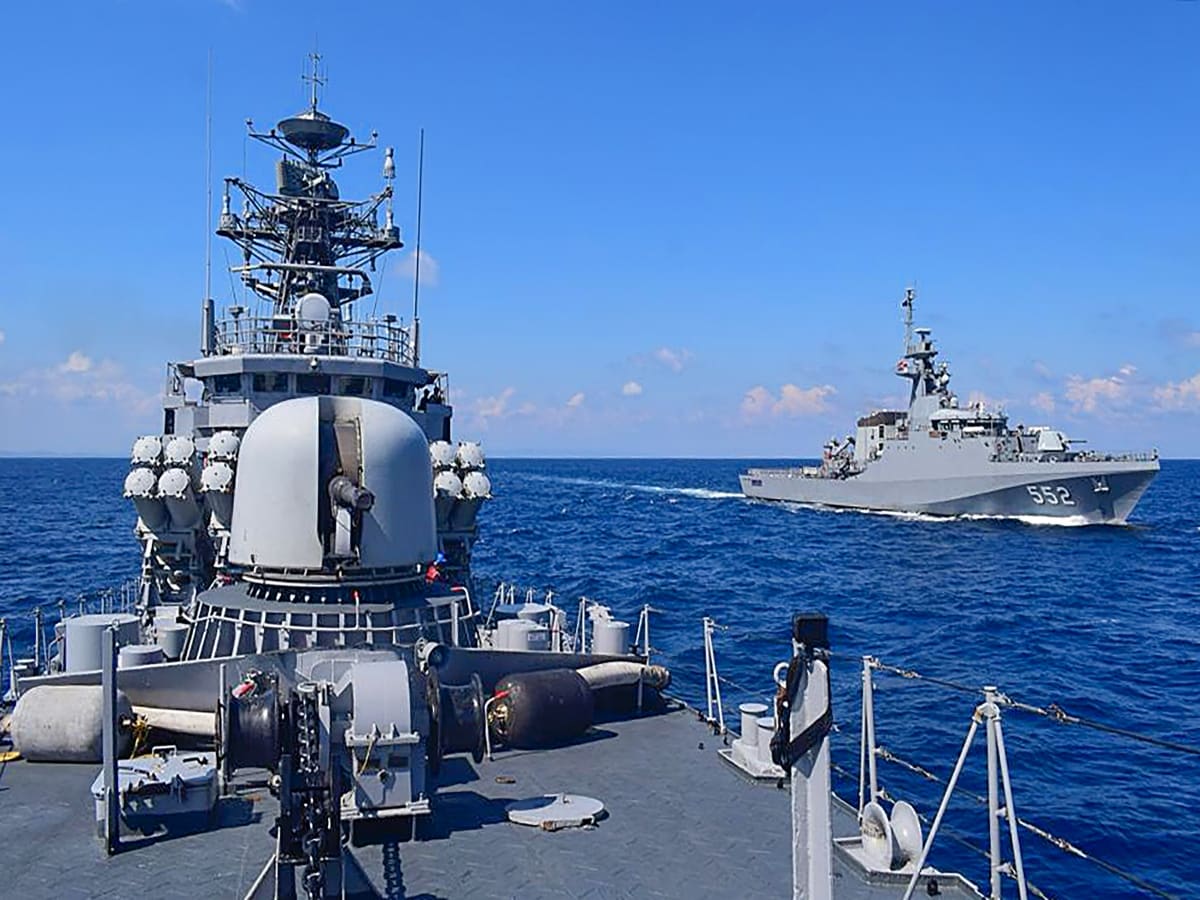Indian Navy Alerts On Chinese Spy Vessel En Route To Maldives In The Indian Ocean; The Maldives-India Tightrope And The Dragon’s Growing Influence
The Indian Navy has raised concerns over the presence of the Chinese survey and research vessel Xiang Yang Hong 03 in the Indian Ocean, en route to the Maldives after being denied permission to dock in Sri Lanka. The vessel, equipped with advanced surveillance equipment, entered the Indian Ocean through the Sunda Strait of Indonesia. India is closely monitoring its movements, with the vessel's previous ocean surveys in the region in 2019 and 2020 raising security apprehensions. Despite not conducting research activities within the Indian Exclusive Economic Zone (EEZ), the Indian Navy is actively tracking the vessel's progression towards the Maldives, expecting its arrival in the first week of February. The Maldives-India-China triangle is a diplomatic war, and chances are that China is on a sounder footing compared to India.

The Indian Navy has alerted about the presence of a Chinese survey and research vessel, Xiang Yang Hong 03, in the Indian Ocean, heading towards the Maldives.
The vessel denied permission to dock in Sri Lanka and is anticipated to reach the Maldives by the first week of February; the Chinese survey and research vessel Xiang Yang Hong 03’s entry into the Indian Ocean occurred through the Sunda Strait of Indonesia on Monday.
An OSINT handle, @detresfa, highlighted the vessel’s prior presence in the region, conducting ocean surveys in 2019 and 2020; however, the vessel’s recent appearance in the Indian Ocean Region (IOR), Bay of Bengal, and the Arabian Sea has raised concerns in India.

India is closely monitoring the Chinese vessel, equipped with advanced surveillance equipment, as it progresses towards the Maldives. Despite the vessel not engaging in any research activities within the Indian Exclusive Economic Zone (EEZ), the Indian Navy is aware of its presence and is actively tracking its movements, according to defence sources.
The Chinese research vessel’s trajectory toward the Maldives may be attributed to China’s imperative following Sri Lanka’s imposition of a year-long moratorium on the entry of Chinese research vessels.
Recently, tensions between India and the Maldives escalated, particularly regarding the presence of Indian troops in the region.
China And Maldives Growing Closeness
Previously, Sri Lanka had rejected China’s request to permit the Xiang Yang Hong 3 to call on its ports for a survey by early 2024. The development coincided with the five-day state visit of Maldivian President Mohamed Muizzu to China, where strategic ties were discussed and agreements were made to enhance cooperation.
In the aftermath of Muizzu’s visit to China, the Chinese Communist Party’s (CCP) Vice-Minister of the International Department is scheduled to visit the Maldives later this month.
CCP’s Sun Haiyan recently met with Muizzu, shortly after the Maldivian leader’s return from China, where they expressed a commitment to strengthening strategic ties.
Following his return, Muizzu announced a March 15 deadline for the removal of Indian soldiers stationed in the Maldives. However, discussions on this matter between New Delhi and the Maldives are described as “ongoing.”
The Foreign Ministers of India and the Maldives held discussions in Uganda during the Non-Alignment Movement (NAM) summit where external Affairs Minister S Jaishankar characterized their conversation as “frank,” addressing the ongoing high-level talks on the withdrawal of Indian military personnel.
Reports indicate a consistent increase in the deployment of Chinese research vessels in the Indian Ocean Region (IOR), particularly around the Ninety Degree East Ridge and Southwest Indian Ridge. These vessels are equipped with advanced snooping capabilities, allowing them to gather diverse data.

China’s Growing Presence In Indian Ocean
China’s presence in the IOR began in 2008 under the guise of anti-piracy operations in the Gulf of Aden. Since then, China has maintained a continuous presence and, on occasion, deployed nuclear attack submarines (SSNs).
An Indian Navy representative informed the Parliamentary Standing Committee on Defence in April 2023 that China’s navy had grown from 250 to over 350 ships in just over a decade, making it the world’s largest navy. It was also noted that China’s operations in the IOR, including research vessels, pose potential security concerns for the region.
What Sparked The Maldives-India Row
The ongoing dispute between India and the Maldives, initially stemming from an online clash among trolls, has evolved into a diplomatic standoff.
Commencing on January 4, when Prime Minister Narendra Modi shared picturesque images from his visit to Lakshadweep without mentioning the Maldives, the situation escalated as social media users questioned the need to visit the Maldives when India possesses such natural beauty.
The backdrop includes a change in the Maldives government, aligning with an anti-India stance, particularly under President Mohamed Muizzu, perceived as pro-China.
The social media skirmish led to derogatory comments against PM Modi by three Maldivian deputy ministers and several MPs, elevating the conflict to a diplomatic level.
India expressed strong concerns to Maldives High Commissioner Ibrahim Shaheeb, who was summoned to the Ministry of External Affairs.
Attempting a delicate balance between China and India, the Muizzu administration indefinitely suspended three officials involved in the social media exchange.
However, discontent among Maldivians became apparent, with many expressing dissatisfaction over the unfolding events.
Meanwhile, Indian tourists in Male echoed a desire for amicable ties between the two nations, emphasizing that the controversy might impact employment in Lakshadweep rather than Maldivian tourism.
The Maldivian Opposition, dissatisfied with the government’s response, called for Parliament to summon the foreign minister and deputy ministers, seeking a more definitive resolution.
Historically, India’s recognition of Maldives’ independence and the establishment of diplomatic relations marked the political significance of their ties.
Geographically, the Maldives’ strategic location in the Indian Ocean near India’s Lakshadweep Islands emphasizes its importance for India’s maritime security. India has implemented a coastal radar network in the Maldives, enhancing surveillance capabilities in the region.
India’s role as a ‘first responder’ during crises in the Maldives, participation in joint military exercises, and involvement in development projects underscore the multifaceted nature of the bilateral relationship.
Despite occasional fluctuations, India remains crucial for the Maldives in various aspects, including tourism, investment, healthcare, education, and cultural engagement and the ongoing dispute underlines the intricacies of maintaining strong ties between the two nations.

Should India Give In To China?
Their distinct strategic interests have influenced the involvement of India and China in the Maldives and approaches toward the Indian Ocean archipelago.
China’s interaction with the Maldives experienced a significant surge during Abdulla Yameen’s presidency, particularly aligned with the Belt and Road Initiative (BRI).
Beijing executed substantial infrastructure initiatives, including the enhancement of the Maldives’ primary international airport and the construction of a bridge connecting Male to Hulhumale.
This expanding presence raised concerns about the Maldives’ increasing indebtedness to China and the potential risks associated with “debt trap diplomacy.”
However, following Mohamed Ibrahim Solih’s election in 2018, there was a reorientation towards strengthening ties with India, evident in Solih’s initiation of an “India First” policy.
This policy shift resulted in India extending financial support for community development projects and infrastructure enhancement in the Maldives.
India’s engagement with the Maldives has been diverse, including defence, economic, and humanitarian aspects.
Historically, India has been a swift responder during crises in the Maldives, such as the 1988 coup attempt and the 2014 water crisis in Male.
The imperative primarily drives India’s approach to upholding stability and security in the Indian Ocean region, as the Maldives’ strategic location renders it a crucial partner for India in terms of maritime security, counter-terrorism, and regional stability.

The Challenges For India
The recent “India Out” campaign in the Maldives, led by former President Yameen and current President Muizzu, has presented challenges for India-Maldives relations.
This campaign protests the perceived encroachment on Maldivian sovereignty due to the presence of Indian military personnel and India’s increasing influence in the Maldives. The domestic political movement in the Maldives reflects a complex interplay of concerns regarding national sovereignty and external influences.
In the context of regional stability, the interactions between India, China, and the Maldives hold significant implications.
The rivalry between India and China in the Indian Ocean region carries consequences for regional power equilibrium and maritime security. The Maldives, positioned amidst this geopolitical competition, grapples with the challenge of maintaining a delicate balance in its relationships with both regional powers.
The outcome of this balancing act carries broader ramifications for the stability and security of the Indian Ocean region.
The significance of the Maldives to both India and China arises from its strategic location and the broader geopolitical competition in the Indian Ocean.
Hence, the evolving dynamics of these relationships will persist in shaping the regional landscape, impacting not only bilateral ties but also the overall stability of the region.
The Last Bit, the developing dynamics between India, China, and the Maldives spotlight a complex interplay of strategic interests, geopolitical influences, and regional stability.
The Maldives, positioned at the crossroads of India and China’s rivalries in the Indian Ocean, faces the challenge of a delicate balance in its relationships with both nations.
While China’s increased engagement during Abdulla Yameen’s presidency raised concerns of “debt trap diplomacy,” the election of Mohamed Ibrahim Solih marked a shift towards strengthening ties with India under an “India First” policy.
The recent “India Out” campaign led by Maldivian leaders has posed challenges for India-Maldives relations, reflecting a domestic political movement grappling with issues of national sovereignty and external influences.
Amidst this, India’s multifaceted engagement with the Maldives, spanning defense, economic, and humanitarian aspects, highlights the strategic importance of the archipelago for India’s maritime security and regional stability.
The broader implications of the regional power balance, maritime security, and the stability of the Indian Ocean region are at stake in this geopolitical tug-of-war.
The significance of the Maldives to both India and China stems from its strategic location, making the evolving dynamics of these relationships key in shaping not only bilateral ties but also the overall stability of the region.
The outcomes of these interactions will continue to influence the geopolitical arena, emphasizing the need for nuanced diplomacy and strategic manoeuvring in the Indo-Pacific.




